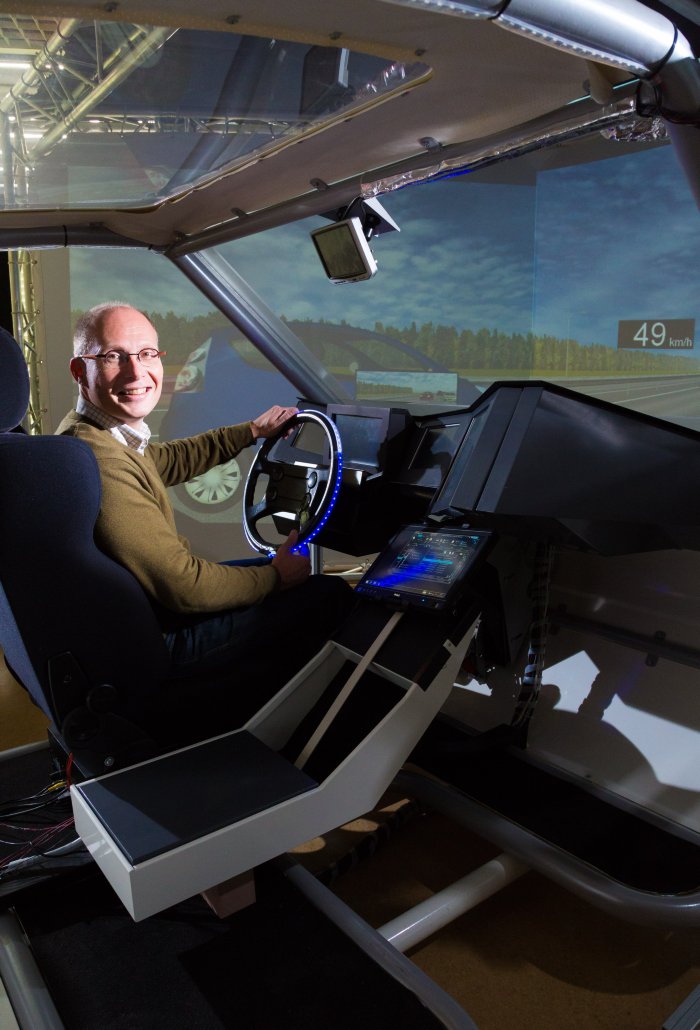Before self-driving cars can really take off as a product, the interaction between vehicles and drivers needs significant improvement.
Arie Paul van den Beukel is convinced that with the current state of art, automated driving makes our driving task rather more complex. He will be awarded his PhD on this topic on 10 November.
In his PhD thesis Mr Van den Beukel describes how automated driving changes the driver’s role from being in control to supervising with occasionally a need to intervene. “Self-driving cars are more comfortable and should ideally make traffic safer. But is that actually possible? In ordinary cars, we have to ensure that the car stays in the lane and that we keep safe distance to other vehicles. We consciously register what is going on around us. With automated driving, the car takes over and we are much less involved in driving the vehicle. However, we are still responsible for what happens on the road. This new role is by no means easier than our old one, as it now mainly consists of monitoring, a task we are generally not very well suited for.”
Split-second decisions
What happens when a self-driving car stops recognizing faded road markings and crosses over into another lane? What happens when someone else crosses into your lane, almost cutting you off? Then, the distance between cars becomes so small that you have to act really quickly. Split-second decisions need to be made. “Howevers, such situations will become more difficult to manage than before introduction of self-driving cars”, says Mr Van den Beukel. “As a driver you are less involved in the driving process and your hands are literally no longer at the wheel. Supervisory drivers take longer to realize something is going on. As you’re no longer actively driving, you become less aware of the situation on the road. In critical situations, that lack of attention can be the blink of an eye in which an accident could have been prevented.”
The researcher also looked into ways of giving support to drivers in getting used to their new role. In the self-driving cars that are currently available, the driver is offered information on how the system is functioning throughout the journey. This is usually presented on a display behind the wheel or in the centre console. Tesla for example has a display offering in-depth information from the sensors. This information is useful, but it also means that drivers have to focus their attention on information inside the car, instead of on what’s happening outside on the road.

Windshields with LED edge
In the University of Twente driving simulator, Mr Van den Beukel experimented with the use of LED lighting along the edges of windshields. Roughly 40 external test subjects participated in the experiment. The changing colour and intensity of the LED lights indicate for example that a situation requires action. For example, the light pulses red when a dangerous driver cuts into the lane at too close distances. “The interfaces in self-driving cars are currently mainly focused on prodiving information on the dashboard. This needs to change.”
After his promotion, Mr Van den Beukel wants to continue researching technological developments that will help increase the social acceptance of automatic driving. “This acceptance depends on whether or not the benefits outweigh the disadvantages of the driver’s new monitoring role. One of the things people may expect is that they will be able to do something else while they’re in the car, such as playing with their smartphones. I want to see if we can offer smartphone-related information in the area around the wheel, but filtered of course. If the situation on the road requires attention, the car stops offering this non-essential information. As far as I’m concerned we need to improve the interaction between the driver, the vehicle and the autopilot system. This really is necessary to achieve the desired benefits such as more comfort and increased safety.”
Lecture on human-centred design
Mr Van den Beukel teaches courses in the UT programmes Industrial Design and Creative Technology. “These courses focus on human-centred design; how can we adapt products to suit users’ capabilities? What immediately comes to mind is ergonomics education, which is now getting revamped because more and more products are becoming part of complex systems requiring more cognitive skills from users.”
Further information
Arie Paul van den Beukel will defend his dissertation entitled Driving automation interface design: supporting drivers’ changing role at 14.30 on 10 November 2016 at the Waaier Building on the University of Twente campus. His supervising professor is Mascha van der Voort. Mr Van den Beukel is conducting research at the department of Design, Production and Management (Faculty of Engineering Technology) and has worked closely with automobile manufacturer Ford.





